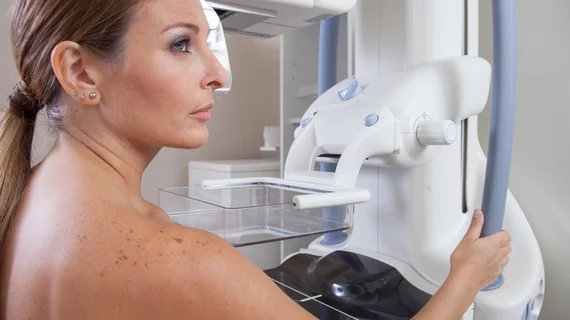Is breast US, mammography or both ideal for women under 40 with focal breast symptoms?
Breast ultrasound should be used as the primary initial imaging modality when evaluating focal breast symptoms in women 30 to 39 years old, according to research published Oct. 9 in the American Journal of Roentgenology. Although mammography can detect symptomatic breast cancer, the researchers found its cancer detection rate (CDR) to be much lower than that of ultrasound.
“Bilateral mammographic evaluation of women 30 to 39 years old presenting with breast symptoms yielded an additional 2.0 incidental cancers per 1000 examinations,” wrote lead author Shinn-Huey S. Chou, MD, a radiologist at Massachusetts General Hospital in Boston, and colleagues. “The low added cancer yield may support the judicious rather than routine use of mammography in this patient cohort.”
For women younger than 40 years old in the U.K., ultrasound is recommended according to the best practice diagnostic guidelines for patients presenting with breast symptoms. It is also recommended if breast imaging is needed before the age of 35, according to the European guidelines for quality assurance in breast cancer screening and diagnosis. However, the U.S. National Comprehensive Cancer Network guidelines recommend mammography, and the American College of Radiology supports either mammography or breast ultrasound.
With contrasting opinions regarding breast imaging for women between 30 to 39 years, does ultrasound, mammography, or both ultrasound and mammography hold value for initial imaging?
Included for analysis were women 30 to 39 years old who underwent mammography and ultrasound for focal clinical concern between June 2006 and August 2016.
To determine lifetime breast cancer risk, the researchers reviewed the participants' medical records for the presence of breast cancer risk factors. Outcomes were determined through imaging and pathology data from a tumor registry.
Of the 4,426 diagnostic examinations of 3,997 women analyzed, the researchers diagnosed 68 breast cancers with a CDR of 15.4 per 1,000 examinations.
Sixty examinations led to biopsy of a finding distant from the presenting symptom site, yielding nine incidental malignancies with a CDR of two per 1,000 examinations. Additionally, the 68 women with breast cancer had an average lifetime risk "significantly" higher than that among age-matched control subjects; 66.2 percent of these women had identifiable risk factors, according to the study.
“Our findings support ACR and European recommendations for targeted breast ultrasound as the initial imaging evaluation of women 30 to 39 years old who have symptoms and support bilateral mammography added to ultrasound for women with risk factors for breast cancer and as an adjunct examination when suspicious or indeterminate sonographic findings are present,” Chou et al. wrote.

